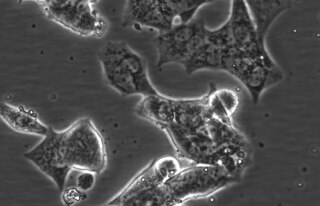
Streptomyces griseus is a species of bacteria in the genus Streptomyces commonly found in soil. A few strains have been also reported from deep-sea sediments. It is a Gram-positive bacterium with high GC content. Along with most other streptomycetes, S. griseus strains are well known producers of antibiotics and other such commercially significant secondary metabolites. These strains are known to be producers of 32 different structural types of bioactive compounds. Streptomycin, the first antibiotic ever reported from a bacterium, comes from strains of S. griseus. Recently, the whole genome sequence of one of its strains had been completed.
The S9 fraction is the product of an organ tissue homogenate used in biological assays. The S9 fraction is most frequently used in assays that measure the metabolism of drugs and other xenobiotics. It is defined by the U.S. National Library of Medicine's "IUPAC Glossary of Terms Used in Toxicology" as the "Supernatant fraction obtained from an organ homogenate by centrifuging at 9000 g for 20 minutes in a suitable medium; this fraction contains cytosol and microsomes." The microsomes component of the S9 fraction contain cytochrome P450 isoforms and other enzyme activities. The cytosolic portion contains the major part of the activities of transferases. The S9 fraction is easier to prepare than purified microsomes.

Tetrahydrocannabinolic acid is a precursor of tetrahydrocannabinol (THC), the active component of cannabis.
Streptomyces albofaciens is a bacterium species from the genus of Streptomyces which produces oxytetracycline, spiramycin, albopeptin A, albopeptin B and alpomycin.
Streptomyces calvus is a bacterium species from the genus of Streptomyces which has been isolated from soil in Dinepur in India. Streptomyces calvus produces nucleocidin, adiposin 1 and adiposin 2.
Streptomyces cavourensis is a bacterium species from the genus of Streptomyces which has been isolated from soil in Italy. Streptomyces cavourensis produces flavensomycin.
Streptomyces collinus is a bacterium species from the genus of Streptomyces which has been isolated from soil in Baden in Germany. Streptomyces collinus produces ansatrienin A2, ansatrienin A3, ansatrienin B, naphthomycin A, collinomycine, toromycin, streptocollin, kirromycin and rubromycine.
Streptomyces djakartensis is a bacterium species from the genus of Streptomyces which has been isolated from soil from Djakarta on Java in Indonesia. Streptomyces djakartensis produces niddamycins and N-acetyltryptamine.
Streptomyces flavoviridis is a bacterium species from the genus of Streptomyces which has been isolated from soil. Streptomyces flavoviridis produces phleomycin and zorbamycin.
Streptomyces griseoplanus is a bacterium species from the genus of Streptomyces which has been isolated from grassland soil in Iowa in the United States. Streptomyces griseoplanus produces alazopeptin, erythromycin and anticapsin.
Streptomyces halstedii is a bacterium species from the genus of Streptomyces which has been isolated from deeper soil layers. Streptomyces halstedii produces magnamycin B, vicenistatin deltamycin A2, deltamycin A3, bafilomycin B1 and bafilomycin C1.
Streptomyces kurssanovii is a bacterium species from the genus of Streptomyces which has been isolated from soil in Russia. Streptomyces kurssanovii produces chitinase, N-(Phenylacetyl)-2-butenediamide and fumaramidmycin.
Streptomyces luteogriseus is a bacterium species from the genus of Streptomyces. Streptomyces luteogriseus produces peliomycin and (+)-(S)-streptonol A.
Streptomyces misakiensis is a bacterium species from the genus of Streptomyces which has been isolated from soil in Japan. 'Streptomyces misakiensis produces tubermycin A, tubermycin B, misakimycin and the endothelin receptor antagonist BE-18257B.
Streptomyces niveus is a bacterium species from the genus of Streptomyces which has been isolated from soil in the United States. Streptomyces niveus produces the aminocoumarin antibiotic novobiocin and the compounds nivetetracyclate A and nivetetracyclate B.
Streptomyces parvulus is a bacterium species from the genus of Streptomyces which has been isolated from soil. Streptomyces parvulus produces the peptide antibiotic Actinomycin D and the angiogenesis inhibitor borrelidin and manumycin A, himalomycin A, himalomycin B and kynurenine.
Streptomyces viridosporus is a bacterium species from the genus of Streptomyces. Streptomyces viridosporus produces sistomycine and lignin peroxidase. Streptomyces viridosporus can degrade lignin and humic acids.

LAPC4 cells are a cell line of human prostate cancer commonly used in the field of oncology. The tissue was harvested from the lymph node metastasis of a male patient with hormone refractory prostate cancer which was then xenografted into SCID mice and later harvested and plated on tissue culture dishes, where it can be propagated as an immortalized prostate cancer cell line.






